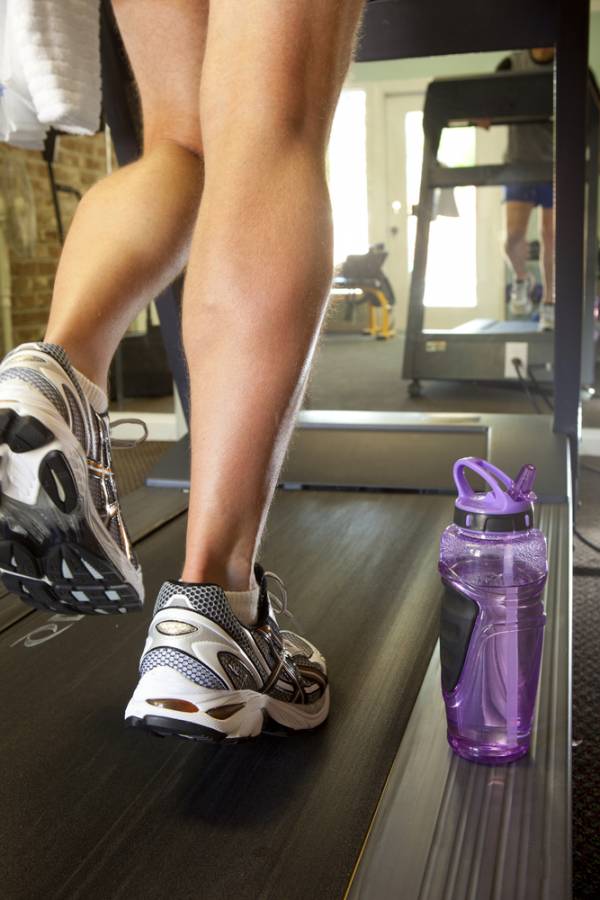Nothing could be a more identifiable sign of the corporate big box gym than the treadmill. Lined up in droves for the sheep that slowly plod their way to nowhere on them while other people do curls in the squat rack. I used to look at them with disdain and scream at people inside my head, “Go run outside.”
But over the last year I’ve really come to appreciate the treadmills for a few different reasons. For starters the surface is softer than running on the sidewalk where I normally run. It’s no secret that old guys and running aren’t a great mix and between my calf and Achilles problems this reprieve has been a blessing. I can run hard on a treadmill and have no pain in my lower legs the next day, as opposed to my normal running route, which can leave me feeling like someone is trying to stick knives into the back of my heels. Less soreness equals more opportunities to train.
Another big benefit is that you can set a target speed and work on being able to hold it. If you know you want to run a forty-minute 10km (a good benchmark for a recreational runner) you need to be able to run 4min/kms or 15km/hr. You can work on that on the treadmill.
A final benefit is that you can do selected hill runs on the treadmill by using the incline function. Hills are where it’s at for developing run specific fitness. Forget deadlifts, squats, or any other exercise you can come up with. It’s all about hills if you want to run fast over distance. But if where you live is flat, it can be difficult to find a decent hill.
My current training has a great treadhill session each week. It’s one of those sessions where I can actually feel the difference the next time I run. Not next week, or in a month’s time, but the very next time I run. That’s training gold if you find a session like that.
In fairness to my coach I can’t share that session. If you want the benefits of his training you’ll need to hire him for his services. But I’ve got two other treadhill sessions that will give you two different types of training – one for top end speed and the other for race pace work.
Treadhills 1: VO2Max
- 10-15 min warm up
- 3 x 3 min hard with 1 min easy running x 1-2
- 10-20 min cool down with easy running
Run the warm up flat, gradually building to a speed you are able to hold while running relaxed.
For the 3-minute hard sections increase incline while keeping the speed the same. I suggest that for most people this will be somewhere between 3% and 5%. After 3 minutes of hard running on the incline, revert back to flat and stay at that same speed. It’s really important you don’t overestimate your relaxed pace, as you have limited recovery between hills.
For beginners (anyone who can’t hold sub 4min/km pace over 10km), do one round of intervals. For better runners, do two. If you are doing the second round of hills, then take a 5-minute break between the first and second 3 x 3 blocks.
Treadhills 2: Race Pace Work
- 10-15 min warm up
- Above and below race pace efforts x 3 x 1-2
- 10-15 min cool down
This is a little tricky and needs some knowledge of how fast you run to make it work. A simple way to figure these speeds is by using this calculator. Fill in the distance you want to run in the race and the target time. Let’s start with a projected 40-minute 10km. That gives you 4min/km as race pace.
 This is where it starts to get really nasty. Adjust the incline slightly – no more than 4% – and bump up the speed to just above race pace. Something like 3.45min/km in our example and run for 2 minutes. After 2 minutes slow the pace down to just below race pace. Something like 4.15min/km would be good here and run two more minutes. By this stage you should have run 1km. Repeat this for two more reps. Experienced runners (those going below a 40-minute 10km) can do another set if they want.
This is where it starts to get really nasty. Adjust the incline slightly – no more than 4% – and bump up the speed to just above race pace. Something like 3.45min/km in our example and run for 2 minutes. After 2 minutes slow the pace down to just below race pace. Something like 4.15min/km would be good here and run two more minutes. By this stage you should have run 1km. Repeat this for two more reps. Experienced runners (those going below a 40-minute 10km) can do another set if they want.
This is a brutal session and doesn’t need to be done every week. You’ll get either 3km or 6km of race pace work up an incline with this session, so be careful as this is one of those sessions that gives enormous benefit but comes with a big recovery cost.
These sessions are good fun and give a lot of benefit almost immediately. Don’t feel the need to do both in a single week though, as a little gives a lot of benefit. The same goes for deciding how many sets of each interval to do – start with one and see what happens. When added to some easy runs and a longer run each week these sessions can add a big boost to your race pace.
Photos courtesy of Shutterstock.






